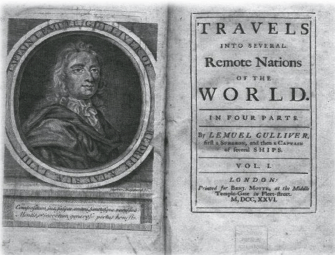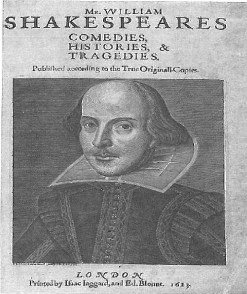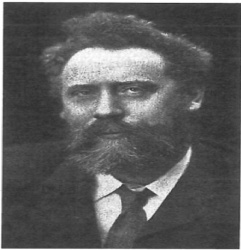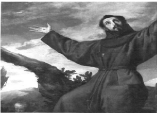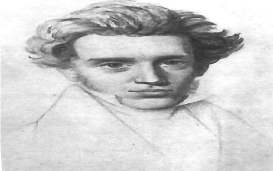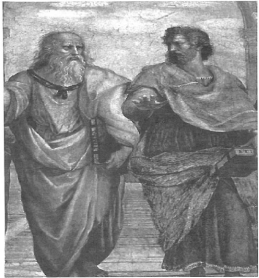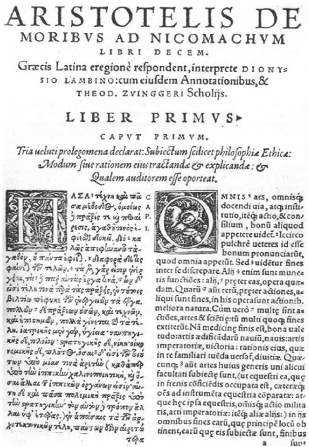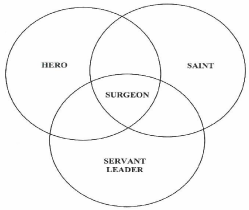Commentary
Surgeons as Heroes and Saints
Rodning CB*
Department of Surgery, University of South Alabama, USA
*Corresponding author: Charles B. Rodning, Department of Surgery, College of Medicine and Medical Center, University of South Alabama, 2451 Fillingim Street Mobile, Alabama 36617, USA
Published: 07 Mar, 2017
Cite this article as: Rodning CB. Surgeons as Heroes and
Saints. Clin Surg. 2017; 2: 1333.
Abstract
The fundamental human question–is human existence meaningful or absurd–must be asked by all sentient beings and surgeons are not immune. Questions regarding the meaning of life may be critically analyzed from multiple perspectives: existentially, dialogically, historically and/ or metaphorically. Regarding the latter, in the occidental intellectual tradition of the journey to wisdom, two archetypical metaphorical figures have emerged that address the question of meaning– the hero and the saint–although an inherent tension exists between them. Nevertheless, there is no discipline which more vividly exemplifies the potential interrelationship between them than the surgical profession. Patients look to the surgeon as a hero, with awe and respect, seeking inspiration and help. Patients look to the surgeon as a saint, with gratitude and humility, seeking solace and hope.
Introduction
"Of freedom and of life he only deserves who every day must conquer them anew" [1]. Faust,
Act V (1828-29) Johann Wolfgang von Goethe (1749-1832). The wonder and mystery of life and the
human condition [2] begins with the Fundamental Human Question:
Is human existence meaningful or absurd?
There is powerful experiential evidence for both meaning and absurdity of the human condition
and existence. The realities of human solidarity, the good, beauty, justice, empathy, altruism and
charity, are exemplary: husband-wife, parent-child, student-teacher, patient-surgeon relationships;
the bonds of comrades-in-arms; the daily dedication of caregivers; humanitarianism; philanthropy;
and artistic and scientific achievements. Yet there is also the problem of evil: war, genocide, the
Holocaust, starvation, slavery, persecution, racism and the irrationality of unfulfilled human
need. Is human existence "sweetness and light" as described by Jonathan Swift [3] in his satire
Gulliver's Travels (Figure 1)? Or "... Life is but a walking shadow, a poor player who frets and struts
his hour upon the stage and then is heard no more. It is a tale told by an idiot, full of sound and
fury, signifying nothing," as described by William Shakespeare) (Figure 2) in his tragedy Hamlet,
Prince of Denmark (Act V, Scene v)? Again I ask, am human existence, am the human condition,
meaningful and purposeful or absurd and abysmal? I commend to you the scholarship of Dr.
Francis J. Ambrosio, Professor [2], Department of Philosophy, Georgetown University, in relation
to this dialectic. Questions regarding the meaning of life may be critically analyzed from multiple
perspectives.
• Existentially: How lives arc actually lived, not in the abstract, not theoretically, but
actually lived; the quality of interpersonal relationships, locally, regionally, nationally and
internationally.
• Historically: Meaning adapted to evolving ecological, environmental, economic,
sociological, political and cultural phenomena.
• Metaphorically: To amplify upon the latter, in the Occidental intellectual tradition of the
path or journey to wisdom, two archetypical and metaphorical (L., inetaphora, "transfer,"
"carry over") figures have emerged that address the question of meaning (ME., Mellen,
"purpose." "teleology") -the hero and the saint.
HERO* derived from the Hellenic/Hellenistic, secular and humanist philosophical traditions
of critical inquiry rational, empirical and material, that address the problem of knowledge, the
problem of conduct and the problem of governance—of Socrates, Hippocrates, Plato, Aristotle,
Zeno, Lucretius, Epicurus, Epictetus, Marcus Aurelius Antonius and Cicero.
SAINT* derived from the ludaeo-Christocentric and Islamic religious, theological and spiritual traditions—faith vis-a-vis reason, mystic ecstasy, dogmatic
scripturalism, providentialism, sacrifice, transcendence, redemption,
forgiveness, righteousness, salvation, revelation and equality of
souls—of Yahweh, God, The Father; the Patriarchs Abraham,
Ishmael, Isaac and Jacob; the Kings Saul, David and Solomon; the
Messiah, Lord, Jesus Christ; James the Just; the Apostles Peter and
Paul; the Saints Augustine, Benedict, Francis and Thomas Aquinas;
and the Prophet Mohammad.
The universe of the hero is shaped by the impersonal forces of
chance and necessity (Gk... ananke), forces indifferent to human
aspirations, hopes, happiness, needs, fears, or suffering. The hero
realizes their individual fate (Gk., moira), their goal of selfhood,
self-fulfillment, self-mastery, self-esteem, self-aggrandizement, selfworth,
by struggle (Gk., agon) —physically, mentally, emotionally,
volitionally-to achieve intellectual and moral excellence and
perfection (Gk., arete). The motive of the hero is achievement, honor
and acclaim bestowed upon self. Invictus. [7] William Ernest Henley
(1849-1903) (Figure 3).
Out of the night that covers me, Black as a pit from pole to pole,
I thank whatever gods may be for my unconquerable soul. In the fell clutch of circumstance I have not winced nor cried aloud. Under the
bludgeonings of chance my head is bloody, but unbowed. Beyond this
place of wrath and tears Looms but the horror of the shade and yet the
menace of the years finds and shall find me, unafraid. It matters not
how strait the gate, how charged with punishments the scroll, I am
the master of my fate: I am the captain of my soul.
Images of the chivalric Knight Errant and the Champion
possessive of the intellectual and moral virtues - knowledge, prowess,
prudence, temperance, courage, justice, fidelity, loyalty and courtesy
- apply.
In contradistinction, in the universe of the saint, meaning
is affirmed providentially. The saint realizes their selfhood, selffulfillment,
self-mastery, self-esteem, self-aggrandizement, selfworth,
in personal relationship to others, both human and divine, by
creating a covenantal bond of caring, commitment, compassion and
concern — the purpose of which is the gift of love itself. The motive
of the saint is love and service (Gk., philos et agape) bestowed upon
others. Prayer of Peace and Junk?) Saint Francis of Assisi (1181-1226)
(Figure 4).
Lord, make me an instrument of your peace. Where there is
hatred, let me sow love. Where there is injury, pardon. Where there
is doubt, faith. Where there is despair, hope. Where there is darkness,
light. Where there is sadness, joy. 0 Divine Master, grant that I may
not so much seek to be consoled, as to console; to be understood, as to
understand; to be loved, as to love. For it is in giving that we receive,
it is in pardoning that we arc pardoned and it is in dying that are born to Eternal Life. Amen.
Images of the Suffering Servant, the Good Samaritan and the
Good Shepherd possessive of the theological virtues - faith, hope and
charity - apply.
Predicated upon this disquisition, we must acknowledge several
perspectives. First, the answer to the fundamental human question
- is human existence meaningful or absurd? — begins and ends in
mystery. There is defacto no definitive answer that can be derived
rationally, logically, inductively, or deductively. It requires what
Soren Kicrkegaard (1813-1855) [9], the Danish theologian and
existentialist philosopher (Figure 5), referred to as a "leap of faith."
Therefore, we must continue our quest. Second, there is an inherent
and perhaps incommensurable and irreconcilable, tension between
the hero and the saint. Their weltanschauung (Ger., "worldviews") arc
radically different. Third, the hero and the saint represent perfection,
an ideal to which we should all aspire, while granting the fallibility
of the human condition. Aristotle (384-322, B.C.E., (Figure 6) in his
treatise Ethica Nicomachea (Figure 7) argued that it is only in the
middle ground (L., aurea mediocratas, "the golden mean") between
the principles of action and the habits of acting, that right reason,
Figure 5: Sketch, circa 1840, of Soren Kierkegaard (1813-1855), by artist
Niels Christian Kierkegaard (1806-1882).
Figure 6: Plato and Aristotle, The School of Athens (1509-1510), fresco
by Raffaello Sanzio da Urbino (1483-1520), in the Stanza della Segnatura,
Apostolic Palace, Vatican City. Plato on the left is depicted with his hand
extended vertically, symbolic of his claim that the ultimate reality — the Forms
— lies beyond what humankind experiences. Aristotle on the right is depicted
with his hand extended horizontally, symbolic of the ordinary empirical world
and moral teaching that are "more real" than the Forms.
right desire and right action are manifest proportionately and in
accord with the laws of nature (Table) [11].
The aforementioned notwithstanding, I would nevertheless
argue a fortiori that there is no discipline or human endeavour which
more vividly exemplifies the potential syncretic and symbiotic interrelationship
— a convergence, a consilience — between the hero and
the saint, than the surgical profession — "the most humane of sciences,
the most empiric of arts and the most scientific of humanities" "the profession, the calling, the vow, the vocation, the covenant, the
sacrifice, the service, that you have chosen (Figure 8). Patients look
to the surgeon as a hero, with awe and respect, seeking inspiration
and help. Patients look to the surgeon as a saint, with gratitude and
humility, seeking solace and hope. I would implore you to adopt
those perspectives as your rubric and your creed. Accordingly, I
charge you to be attentive — to be mindful — of your continuing
quest for meaning, with desire, determination, devotion, discretion,
duty, discipline, decorum and deliberation. I charge you to put on the
mantle of heroism, saintliness and servant leadership. And for your
patients, your families and your fellow citizens; as heroes — I charge
you to be a source of inspiration and help and as saints — I charge you
to provide the gifts of solace and hope. Perhaps then, philos et licentia
conscientia ipse et alias est vitae significatio et essentia (L., "love
and freedom of conscience, for self and other, are the meaning and
essence of life."), is one answer to the Fundamental Human Question.
"...befriending the sick and suffering, helping those who cannot help
themselves, rescuing valuable lives from the clutch of grim death and
lessening the sad sum of human misery and pain" [12]. Counsels and
Ideals (1905) Sir William Osier (1849-1919).
Figure 1
Figure 2
Figure 3
Figure 4
Figure 4
Portrait, circa 1642, of Saint Francis of Assisi (1181-1226), by
tenebrist painter Jr sepe de Ribera (1591-1652).
Figure 5
Figure 5
Sketch, circa 1840, of Soren Kierkegaard (1813-1855), by artist
Niels Christian Kierkegaard (1806-1882).
Figure 6
Figure 6
Plato and Aristotle, The School of Athens (1509-1510), fresco
by Raffaello Sanzio da Urbino (1483-1520), in the Stanza della Segnatura,
Apostolic Palace, Vatican City. Plato on the left is depicted with his hand
extended vertically, symbolic of his claim that the ultimate reality — the Forms
— lies beyond what humankind experiences. Aristotle on the right is depicted
with his hand extended horizontally, symbolic of the ordinary empirical world
and moral teaching that are "more real" than the Forms.
Figure 7
Figure 8
Table 1
References
- von Goethe JW. Great outer court of the palace. Faust. Act V. (Priest GM, Translator). New York, Alfred A. Knopf, 1941.
- Ambrosio FJ. The discipline of dialogue. In: Values in. Conflict. O'Callagen P, editor. Lanham, University Press of America, 1997.
- Swift J. Gulliver's Travels. Signet Classic, New York, New American Library, Penguin Putnam, 1999.
- Shakespeare W. Hamlet, Prince of Denmark (Edwards P, Editor). Cambridge, Cambridge University Press, 2003.
- Ambrosio FJ. The Question of Christian Philosophy Today. New York, Fordham University Press, 2000.
- Ambrosio FJ. Dante and Derrida: Face to Face. Albany, State University of New York Press, 2007.
- Henley WE. Invictus. In Modern British Poetry (Untermeyer L, Editor). New York, I larcourt, Brace & Howe, 1920.
- Renoux C. La Priere Pour la Paix Attribuee a Saint Francois: Une Enigme a Resoudre, Paris, Editions Franciscaines, 2001.
- Kierkegaard SA. Fear and Trembling. London, Penguin Books, 1985.
- Aristotelis. Ethica Nicomaclzea. Oxford, Oxford University Press, 1894.
- Pellegrino ED. Humanism and the Physician. Knoxville, University of Tennessee Press, 1979.
- Osler W. Counsels and Ideals from the Writings of William Osier. Boston, Houghton Mifflin, 1905.

